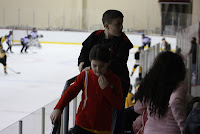There is something magical happening with mite hockey players at the Champlin Ice Forum in the State of Hockey. As their small bodies fly across the ice, with sticks in hand and sheer determination on their faces, the 7 and 8 year olds in the Champlin Park Youth Hockey Association are chasing after more than pucks this season. The goal is bigger than scoring. The mission is to create a foundation to build good skils and good character.
Education with Hockey as the Hook
Focusing on positive athletic experiences through skill development, combined with parent and player education has long been the mission for Minnesota Hockey’s Hockey Education Program. That’s exactly what’s happening with the Champlin Park mites. With Coach Wade Gjervold at the helm, the lessons on the importance of assists and positioning, start early and are often repeated. The gameplan is not all that complicated; come up with drills and team building exercises to keep the kids focused on skills and having fun.
Teamwork 101
On the ice, there are many shining examples of sizzling chemistry. From the mites fist bumps to their line mates after a great play, to rock solid performances by defensemen Soltis, and Klein. Mackeben, Wekseth and Peterson have learned how to successfully plan and position themselves for face offs and passing. Goalie Catlett never finishes a game without a team huddle of thanks and appreciation. A tell tale sign of how much these kids enjoy the team concept comes after practice. Rather than rushing from the locker room to the parking lot, you will see Zahalka, Brooks, Milton and Payne grabbing their sticks and practice balls as a testament to their love of the game and determination to perfect those passes.
Book Break
Off ice strategy has included discussions on how not to be an Eddie. Eddie who? There’s usually one on every team. He’s the kid who never passes the puck, whose ego grows with his stat sheets and one of the main characters in a children’s book called, The Puck Hog. It’s a hockey story with sportsmanship on the cuffs at all points in time. In January, Positive Coaching Alliance listed The Puck Hog on its Recommended Reading list, and described it as a delightful book that presents coping mechanisms for players with teamwork challenges. Mite hockey player Jack Mackeben was the first to gain possession of the story. After reading it, he decided it shoudn’t just sit on his bookshelf. He decided to pass the book to his friends and teammates. The story line had an immediate impact on the team’s lines, with the players passing more and discovering the joy in assists, both on and off the ice. To help her son internalize the message, Westin’s mom Sheila Gjervold, substituted her son’s name while reading with him for the character who was heralded for her unselfish act on the ice.
When Amy and Jace Reed read the book with their son Gavin, it gave them the opportunity to have those important conversations that focus on integrity and teamwork, both on and off the ice.
Parent Partnership
The Puck Hog author, Christie Casciano Burns, is a veteran hockey mom from Syracuse, New York and writes a hockey mom advice column for USA Hockey Magazine. She based these stories on her children’s youth hockey experiences. She now shares a special connection with the Champlin Park team. Casciano Burns reached out to Jack’s mom with a request to personalize Jack’s copy of The Puck Hog. In a matter of a few quick e-mails the hockey moms realized they had much more than youth hockey in common. Both moms are on the same page in their beliefs that minor hockey can teach our children major life lessons. They are teaming up to keep the hockey experiences positive and help the kids realize a real star, makes everyone shine.









